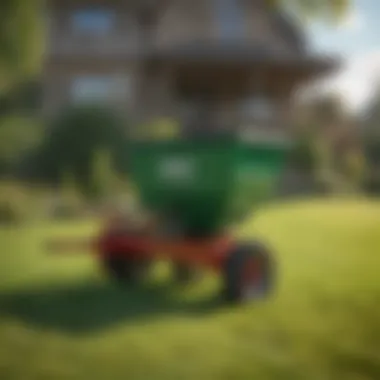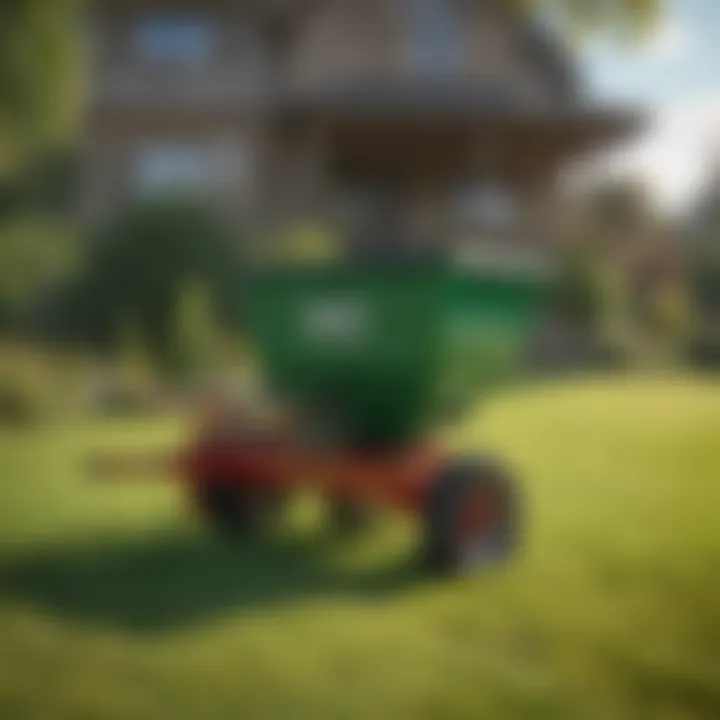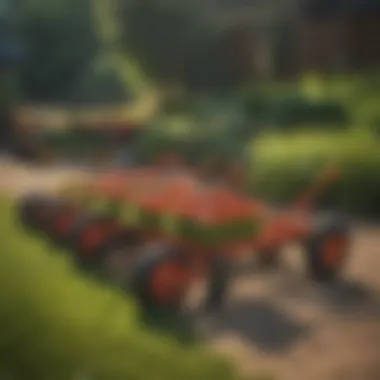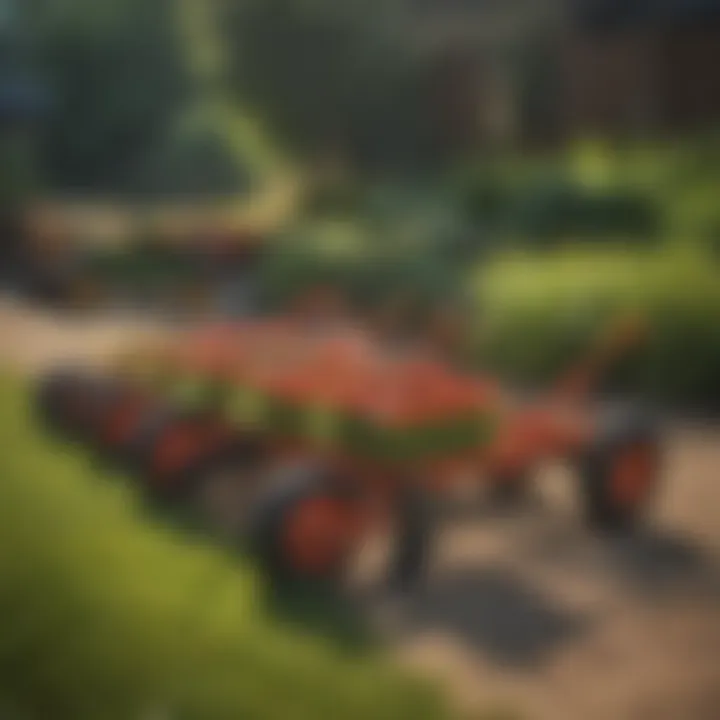The Comprehensive Guide to Small Lawn Fertilizer Spreaders


Intro
In recent years, the importance of effective fertilization in lawn and crop management has grown immensely. Selecting the right tools can significantly influence the overall health and aesthetics of various types of green spaces. This guide aims to dissect the realm of small lawn fertilizer spreaders, offering insights into their features, types, and best practices to ensure balanced distribution of nutrients.
A small lawn fertilizer spreader can optimize lawn care efforts. It's not merely a tool for spreading fertilizer; it represents a commitment to cultivating healthy soil and achieving lush greenery. Understanding their functionality and usage is vital for both casual gardeners and dedicated agricultural professionals.
By delving into the analysis of different spreaders, readers can expect to come away with a thorough understanding of how to select the right spreader for their specific needs, techniques for optimizing fertilizer use, and maintenance tips to prolong the life of their equipment.
Prelims to Small Lawn Fertilizer Spreaders
Small lawn fertilizer spreaders are essential tools for maintaining healthy lawns. They help distribute fertilizer evenly, which is crucial for the optimal growth of grass and other plants. Understanding how to use these spreaders effectively can greatly impact the aesthetic and health of your garden or lawn area. In this section, we will explore their definition, functionality, and importance in lawn care.
Definition and Functionality
Small lawn fertilizer spreaders refer to devices designed to apply fertilizers over a designated area, typically a lawn or garden. There are various types available, tailored for specific needs and sizes of gardens. The functionality of these spreaders hinges on their design, which allows for a controlled release of granules or liquids according to calibrated settings. In general, they either broadcast or drop the fertilizer.
- Broadcast Spreaders distribute product in a wide pattern, making them suitable for larger areas.
- Drop Spreaders provide more precise application directly under the spreader, thus reducing overlap and waste.
This functionality enables users to ensure an even application of nutrients, preventing patches of over-fertilization that could lead to grass burn or uneven growth.
Importance in Lawn Care
The importance of using a small lawn fertilizer spreader cannot be overstated. First, it simplifies the fertilization process. Instead of manually spreading granules, which can lead to uneven application, a spreader ensures that nutrients reach all areas of the yard consistently.
Additionally, using the correct spreader contributes to:
- Efficient use of fertilizers: It minimizes waste by applying the correct amount at the right time.
- Promoting healthy growth: Proper nutrient distribution supports robust grass growth, enhancing your lawn's health, and appearance.
- Saving time and labor: Using a spreader significantly reduces the manual effort involved in fertilizing.
"Employing a small lawn fertilizer spreader translates to better efficiency and an aesthetically pleasing lawn, fostering the right conditions for growth."
In summary, understanding small lawn fertilizer spreaders is essential for anyone interested in maintaining a beautiful and healthy lawn. Their ability to apply fertilizers evenly ensures that the lawn receives the necessary nutrients, promoting health and vigor.
Types of Small Lawn Fertilizer Spreaders
Understanding the different types of small lawn fertilizer spreaders is essential for effective lawn care. Each type has unique features that cater to specific needs and conditions.
Broadcast Spreaders
Broadcast spreaders are known for their ability to cover large areas. They distribute fertilizer in a wide pattern, which can save time during application. As the spreader is pushed, it throws the fertilizer in a circular motion, allowing for quick coverage of a lawn. This type is ideal for larger, open areas where coverage speed is a priority. However, one must be cautious about the evenness of the distribution, especially near flower beds or gardens, as the wider spread can lead to uneven nutrient application.
Drop Spreaders
Drop spreaders offer precision in fertilization. Unlike broadcast spreaders, which disperse material widely, drop spreaders release fertilizer directly below the unit. This targeted application minimizes the chances of over-fertilization in unwanted areas. Drop spreaders are particularly useful for smaller, intricate lawns or when working around obstacles such as trees or shrubs. However, they may require more time to cover the same area due to their narrower coverage.
Hand-Held Spreaders
Hand-held spreaders are designed for ease of use and portability. They are suitable for small lawns or garden patches. Most hand-held models allow for manual control over the amount of fertilizer applied, making them a versatile tool for homeowners. Although they excel in convenience, these spreaders can be physically demanding for larger areas, as users must walk considerable distances to achieve desired coverage.
Tow-Behind Spreaders
Tow-behind spreaders attach to lawn tractors or ATVs, making them efficient for applying fertilizers over larger areas without requiring excessive physical effort. These spreaders can carry a significant load, which can save time and ensure a more uniform application. They are particularly advantageous for those with extensive lawns or agricultural settings. Nevertheless, compatibility with the machinery is crucial, as not all tow-behind spreaders are created equal regarding attachment methods and weight capacity.
Each type of spreader serves a specific purpose and collaboratively enhances overall lawn care efficiency.


Choosing the Right Spreader for Your Needs
Selecting the appropriate small lawn fertilizer spreader is crucial for achieving the desired outcome in lawn care. This decision directly influences how effectively fertilizer is distributed across the lawn, potentially impacting the health and appearance of the grass or plants. A well-chosen spreader not only optimizes the application of nutrients but also can save time and reduce waste, making it a vital aspect for enthusiasts and farmers alike.
Assessing Lawn Size and Type
The first step in choosing a spreader is understanding the specific size and type of your lawn. For small to medium lawns, a hand-held or drop spreader may be sufficient, while larger areas might benefit from broadcast or tow-behind models. If the lawn has features like steep slopes or intricate layouts, a smaller, more maneuverable model can be advantageous. Knowing these factors helps determine not just the type of spreader to acquire but also its size and capacity.
Budget Considerations
Budget is another vital aspect to consider when selecting a fertilizer spreader. Prices vary significantly across different models and brands. A higher-priced spreader may offer advanced features and durability, but a more affordable spreader could fulfill basic needs effectively. Evaluating what you are willing to spend involves weighing the features against your specific requirements. It’s prudent to consider not just the initial cost but also the long-term value of the spreader in terms of durability and performance.
Feature Analysis
Capacity
The capacity of a spreader refers to how much fertilizer it can hold at one time. A higher capacity can reduce the number of refills needed, which saves time during application. For larger lawns, a spreader with a higher capacity can be a beneficial choice, minimizing interruption during the fertilization process. However, it is essential to match capacity with the actual lawn size to ensure even coverage and effective nutrient distribution.
Adjustable Settings
Adjustable settings allow users to modify the rate of fertilizer application according to the needs of the lawn. This feature is particularly important as different fertilizers may require different application rates. The key characteristic of adjustable settings is flexibility. Users can fine-tune the spread according to specific lawn conditions or preferences. In practice, this translates to more precise nutrient management and can lead to healthier grass without risk of over-fertilization.
Ease of Use
The ease of use of a lawn fertilizer spreader greatly contributes to its overall effectiveness. A spreader that is easy to handle, operate, and maintain encourages regular use and reduces the likelihood of incorrect application. Key characteristics include a comfortable grip, lightweight design, and accessible controls. These features enhance user experience, making the fertilization process simpler and less labor-intensive. A user-friendly spreader can improve efficiency and ensure that the lawn receives proper care consistently.
Selecting the right spreader involves a balance of different considerations. Understanding lawn size, budgeting wisely, and analyzing features will lead to an informed decision that promotes a healthy lawn.
Benefits of Using a Small Lawn Fertilizer Spreader
Using a small lawn fertilizer spreader has several merits that can significantly influence the health and appearance of your lawn. These tools translate into precise and effective use of fertilizers, enabling users to achieve better results with less effort. Below, we will examine the key benefits that stem from utilizing a lawn fertilizer spreader, demonstrating how these advantages cater to both aesthetic and functional aspects of lawn maintenance.
Efficiency in Fertilizer Application
One of the most crucial benefits of using a fertilizer spreader is the efficiency it brings to the application process. Instead of relying on manual methods, which often lead to uneven distribution and variable results, spreaders ensure that fertilizers are applied uniformly across the lawn. This efficiency is particularly noticeable when treating larger areas, where factors such as fatigue and human error can impact performance.
The time saved through a systematic approach greatly optimizes work. Setting up the spreader and traveling across the lawn requires less physical labor compared to hand-spreading techniques. This efficiency means homeowners and agricultural enthusiasts can dedicate time to other essential tasks, enhancing overall lawn care management.
Even Distribution of Nutrients
Another significant advantage of using a spreader is the even distribution of nutrients. Fertilizing unevenly can lead to patches of over-fertilization, which might damage your grass or lead to nutrient deficiencies elsewhere. This imbalance can promote weed growth in certain areas, complicating maintenance efforts.
With a properly calibrated spreader, which can often be adjusted for different types of fertilizers, users can expect consistent results. By applying the correct rate of fertilizer uniformly, the spreader aids in achieving a healthier and more aesthetically pleasing lawn. Such uniformity is essential in promoting the overall growth and sustainability of your grass, contributing to the long-term health of your outdoor spaces.
Reduced Waste and Cost-Effectiveness
In addition to efficiency and even distribution, using a small lawn fertilizer spreader can notably reduce waste. When fertilizers are carefully measured and evenly distributed, there is a lower likelihood of excess product that could wash away, evaporate, or become trapped in the soil.
By minimizing waste, not only does this method prove cost-effective, but it also leads to more responsible usage of resources. Over time, users can see a reduction in their fertilizer spending. This aspect is particularly important for farmers and those maintaining large areas, where cost management is a consideration. Ultimately, the effective use of a spreader means all nutrients are utilized properly, aligning with environmentally sustainable practices.
"Efficient fertilizing practices lead to healthier plants and a thriving lawn."
Best Practices for Operating a Lawn Fertilizer Spreader
Using a lawn fertilizer spreader properly is crucial for achieving optimal results in lawn care. The application of fertilizer should not be a haphazard process; instead, it requires attention to detail and a few best practices to ensure an even and effective distribution. By following established guidelines, you can enhance the health of your lawn and ensure that your fertilizer investment yields the results you desire.


Preparation Before Application
Before you start using a spreader, preparation is necessary. This step cannot be overlooked as it influences the efficiency and effectiveness of your fertilizer application. Here are key points to consider:
- Mow the Lawn: Ensure your grass is cut to a uniform height. This helps in assessing coverage and gives you a clear picture of areas that require more attention.
- Clear Debris: Make sure the lawn is free of leaves, twigs, or any debris that could interfere with the spreader's operation. Any obstructions can lead to uneven distribution.
- Select the Right Fertilizer: Know what type of fertilizer you are applying. Different fertilizers have varying nutrient compositions, and some spreaders are designed for specific types of products.
By undertaking these steps, you set the stage for successful fertilizer application.
Calibration of Spreader Settings
Calibration is essential in ensuring that the right amount of fertilizer is applied. Incorrect settings can lead to either over-application, which can harm your lawn, or under-application, which will not provide the nutrients needed for growth. Here are some points to keep in mind for calibration:
- Consult the Manual: Most spreaders come with a manual that indicates the recommended settings for various types of fertilizers. Following this guidance is the best starting point.
- Measure the Lawn Area: Knowing the size of the area you are treating is crucial for determining how much fertilizer you need and the spreader settings required.
- Test It Out: If you are unsure about the settings, you can use a test area on your lawn. Apply the fertilizer to a small section to see how effectively it is distributed before proceeding to the entire lawn.
Timing and Weather Considerations
When you apply fertilizer, timing is important. Both the time of year and the weather conditions can impact how well the fertilizer works. Here are important factors to consider:
- Best Seasons: Spring and fall are often the best times for fertilizing. During these seasons, grass is actively growing, which means it can absorb nutrients more effectively.
- Avoid Rainy Days: Fertilizer application right before rain can wash away nutrients, leading to waste. It's best to wait until after rain to apply, allowing the lawn to dry.
- Check Temperature: Extreme weather that is too hot or too cold can affect how the grass responds to fertilizer. Fertilizing in moderate temperatures ensures better absorption and minimizes stress on the lawn.
"Proper timing and attention to weather can elevate the effectiveness of fertilizer applications, ensuring that your lawn thrives."
By adhering to these best practices, you will improve the effectiveness of your fertilizer spreader, leading to a healthier lawn overall. These steps also help in reducing waste and maximizing your investment in lawn care.
Maintenance and Care of Lawn Fertilizer Spreaders
Maintaining and caring for lawn fertilizer spreaders is crucial for optimal performance and longevity. A well-maintained spreader operates efficiently, ensuring consistent fertilizer distribution. This can impact the health of your lawn significantly, since uneven application can lead to patchy growth and nutrient deficiency. Regular upkeep prevents mechanical failures and saves money on repairs or replacements. Therefore, understanding maintenance best practices is essential for anyone looking to enhance their lawn care regimen.
Cleaning After Use
Cleaning your lawn fertilizer spreader after each use is a vital step in maintenance. Residual fertilizer can lead to corrosion and damage over time. Begin by emptying all remaining fertilizer. Then, use a brush or a hose to clean the spreader. Pay special attention to the hopper and distribution mechanism. Make sure no granules are left inside. Once cleaned, let it dry before storing. This practice not only prevents rust but it also ensures that your next application will not be contaminated with leftover materials.
Storage Recommendations
Proper storage of your spreader can extend its lifespan significantly. Store it in a dry and sheltered area to prevent exposure to the elements. If possible, keep it indoors in a garage or shed. Using a tarp or cover can also be helpful to shield it from dust and moisture. Additionally, consider raising it off the ground to avoid contact with moisture. This minimizes the risk of rust developing, especially on metal parts. Remember, a spreader that is stored correctly is less likely to incur damage.
Periodic Inspections and Repairs
Conducting periodic inspections ensures that your spreader remains in good working condition. Before each season, inspect all components for wear and tear. Check wheels, axles, and the hopper for any signs of damage. If you spot issues, address them immediately to avoid bigger problems later. This may involve tightening screws or replacing worn parts. Keeping your spreader in optimal condition not only improves performance but can prevent costly repairs in the future. Regular maintenance checks can save you both time and money.
Always prioritize maintenance; it pays dividends in the long run.
Troubleshooting Common Issues
Addressing common issues with small lawn fertilizer spreaders is essential for maintaining their effectiveness and longevity. Problems can arise during usage which may lead to uneven fertilizer application or even mechanical breakdowns. Efficient troubleshooting helps users to quickly identify issues and apply appropriate solutions, enhancing the overall efficiency of lawn care tasks. This section will elaborate on two significant problem areas: distribution problems and mechanical failures, both of which can impact the performance of your spreader.
Distribution Problems
Distribution problems typically manifest as uneven or inconsistent application of fertilizer. This issue can lead to sections of the lawn receiving either too much or too little fertilizer, negatively affecting growth and soil health.
Several factors can contribute to uneven distribution:
- Calibrating Settings: Users must ensure that the spreader settings are adjusted according to the fertilizer type and the specific spreader model. Incorrect settings can result in either over-fertilization or under-fertilization.
- Spreader Movement: The speed at which the user walks while operating the spreader can also affect distribution. Maintaining a steady pace is crucial to ensure an even spread of materials.
- Product Consistency: The type of fertilizer is another factor. Granular fertilizers come in various sizes, and if a product is clumpy or not uniform, it can cause blockages or irregular flow during application.
Tip: Always test the spreader on a small section of lawn before a full application. This practice allows you to assess the distribution rate and make necessary adjustments.


Mechanical Failures
Mechanical failures can be detrimental to lawn care operations, often resulting in delayed applications or complete cessation of spreader functions. Understanding common mechanical failures is vital for users.
Common issues include:
- Broken Parts: Wear and tear can lead to broken wheels, cracked hoppers, or damaged handles. Regular inspections can help catch these issues early.
- Clogged Mechanisms: Fertilizer can sometimes clog the spreader, particularly if damp or improperly stored. Clearing the mechanisms regularly is important to prevent disruptions.
- Faulty Gear or Motor: In motorized spreaders, issues with gears or the motor itself may cause malfunction. Users should follow the manufacturer’s guidance on how often to inspect and service these components.
To minimize downtime due to mechanical failures, users should:
- Conduct Routine Maintenance: Regular cleaning and inspections can help identify potential issues before they escalate.
- Refer to the Manual: Every spreader model comes with specific operational details. Understanding the unique features and maintenance requirements will aid in troubleshooting effectively.
- Seek Professional Help: For complex mechanical issues, relying on professional services may be necessary.
By applying the troubleshooting strategies outlined in this section, users can significantly enhance the performance and longevity of their small lawn fertilizer spreaders, ensuring a healthier and more aesthetically pleasing lawn.
Environmental Considerations and Best Practices
The use of small lawn fertilizer spreaders brings with it a significant responsibility. As farmers and gardening enthusiasts increasingly embrace sustainable practices, understanding the environmental considerations and adopting best practices becomes critical for effective lawn care. This section delves into sustainable fertilizer options and their impact on soil health, aiming to guide users towards more eco-conscious decisions that benefit both their lawns and the environment.
Sustainable Fertilizer Options
Choosing sustainable fertilizer options is essential to reduce the negative impact of lawn care on the environment. Here are some approaches to consider:
- Organic Fertilizers: Products like compost and manure are derived from natural sources. They enrich the soil without introducing harmful chemicals. Organic fertilizers release nutrients slowly, ensuring a steady supply for plants.
- Synthetic Alternatives: If opting for synthetic fertilizers, select those labeled as slow-release. Such formulations minimize the risk of nutrient runoff, which can harm local waterways.
- Local Products: Supporting local suppliers reduces transportation emissions. Look for locally-produced fertilizers that are tailored to your regional soil needs.
"Choosing sustainable fertilizers not only enhances lawn health but also promotes ecological balance."
By understanding the various sustainable options, lawn caretakers can make informed choices that align with environmentally friendly practices.
Impact on Soil Health
Soil health is the foundation of a thriving lawn. Various factors influence it, and the application of fertilizers plays a pivotal role. Here are key points to understand:
- Microbial Activity: Sustainable fertilizers enhance microbial life in the soil. Beneficial microorganisms break down organic matter, releasing nutrients essential for plant growth.
- Soil Structure: Using organic fertilizers improves soil texture and structure. This leads to better water retention and aeration, challenging compacted soil issues.
- Nutrient Cycling: Proper application and sustainable choices encourage nutrient cycling. This natural process enriches the soil, making lawn care efforts more productive.
Being aware of the impact of fertilizers on soil health allows lawn caretakers to commit to practices that reinforce the ecological balance. The choices made in the fertilizing process have far-reaching implications, making it essential to prioritize sustainability not just for lawns but also for the larger ecosystem.
In summarizing the environmental considerations underlying lawn care, both the types of fertilizers used and their effect on soil health can determine the sustainability of the practices employed. By pushing for environmentally friendly choices, users not only enhance their lawns but also contribute to broader environmental conservation efforts.
Future Trends in Fertilizer Spreaders
The landscape of lawn care is evolving rapidly. As more homeowners and professional landscapers recognize the need for effective lawn fertilizer application, future trends in fertilizer spreaders are becoming increasingly significant. This section examines these trends while highlighting the benefits and considerations for users. Understanding these trends is crucial for anyone aiming to enhance their lawn care practices.
Technological Advancements
New technology is revolutionizing how fertilizer spreaders operate. Innovations include GPS technology, which allows for precise application based on the specific needs of the soil. This minimizes the overuse of fertilizers, ultimately protecting the environment while ensuring that plants receive adequate nutrition.
Another advancement is the development of electric and battery-powered spreaders. These options provide more efficient usage with less noise compared to traditional gasoline-powered models. Not only do they offer quieter operation, but they also contribute to a reduction in carbon emissions.
Automation is also becoming a key feature in modern spreaders. Systems that allow for automated calibration and adjustment can save users time and effort. As users can set the desired application rate, these automated features ensure that the spreaders deliver a consistent and efficient spread of fertilizer over the entire lawn.
Integration with Smart Farming Tools
The integration of fertilizer spreaders with smart farming tools marks a significant trend. Smart farming encompasses technologies that assist in various agricultural processes. Fertilizer spreaders are now compatible with smartphones and tablets, enabling users to control and monitor their spreaders remotely.
This integration enhances data collection and analysis. By tracking application patterns and effectiveness through various apps, users can make informed decisions on future applications. Therefore, these tools not only provide ease of use but also contribute to effective long-term lawn management.
Moreover, smart sensors attached to spreaders can detect soil moisture and nutrient levels. This ensures that fertilizer is applied only when necessary, optimizing resources and minimizing runoff. This trend towards more intelligent devices confirms the importance of adapting to modern technology in lawn care practices.
"The integration of fertilizer spreaders with smart tech reflects a growing understanding of sustainable practices in promotion of effective lawn care."
As the trends in fertilizer spreaders evolve, so do the opportunities for improved lawn care management. Users must remain informed about these changes to leverage the benefits they offer. Embracing technology in lawn care not only increases efficiency but also supports a more sustainable approach well suited for future generations.



